Why This Comparison Matters: Chopta’s Two Faces
Chopta tour package whether you’re navigating July’s torrential downpour or January’s snow-laced silence—is not just a trip; it’s a rendezvous with dual Himalayan moods. Standing atop Chandrashila summit during monsoon mist and later amidst glacial stillness, I understood this trail isn’t merely a route to Tungnath Temple—it’s a liquid staircase in summer, a frozen slide in winter. It’s about choosing which face of the Himalayas calls to you.
Landscape Transformations: Nature’s Seasonal Theater
The Chopta Tungnath Trek rewrites its script every season. During monsoon (July-September), the 3.5km path to Tungnath Temple morphs into a flowing stream where your boots splash through crystal-clear runoff. Over fifty temporary waterfalls erupt between Sari Village and Chandrashila—some crossing the trail like surprise shower stalls. The rhododendron forests turn into glowing emerald cathedrals, their leaves polished to a mirror shine by relentless rains.
Come winter (December-February), the landscape undergoes a magical transformation. Knee-deep snow converts the Chandrashila summit trek into a Narnian expedition. Frozen waterfalls create ice sculptures worthy of museum display, and Tungnath stone steps vanish completely under snowdrifts, requiring careful navigation with specialized gear.
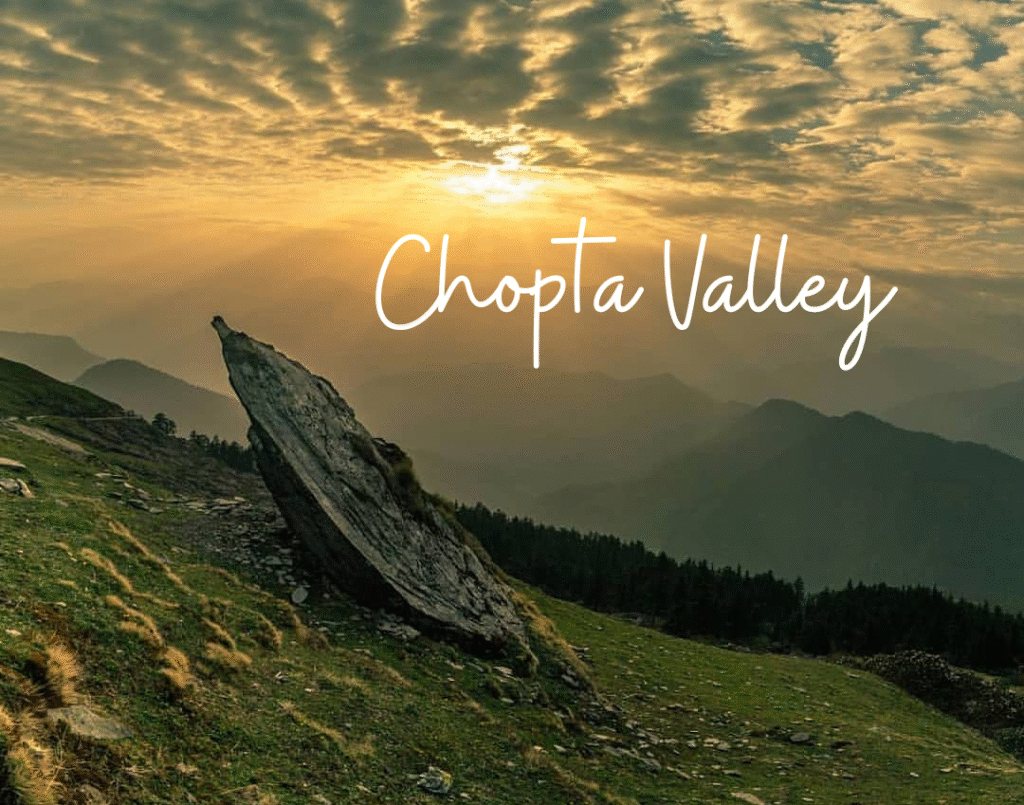
Trek Difficulty: Different Challenges
The Chandrashila summit trek offers a dramatically different experience depending on the season. Monsoon tests your balance as you navigate slippery rocks and sudden stream crossings. Quick-drying layers become essential as afternoon showers arrive without warning. Visibility fluctuates—one moment you’re walking through dense mist, the next you’re rewarded with breathtaking rainbow windows when clouds part unexpectedly.
Winter presents its own set of challenges. Sub-zero temperatures demand meticulous layering—typically four insulating layers beneath a windproof shell. The snow-covered trails require microspikes or crampons for safe passage, and shorter daylight hours mean careful timing is crucial to summit before afternoon winds pick up. Where monsoon tests agility, winter challenges endurance—making the Chandrashila summit trek not just scenic, but also a test of your seasonal strategy and resilience.
Unique Seasonal Magic
Monsoon Magic in Chopta Tour Package
Monsoon brings exclusive experiences with your Chopta tour package, like participating in Tungnath’s special Shravan month rituals where rainwater mingles with temple offerings during sacred abhishek ceremonies. The air carries the intoxicating petrichor scent—that earthy fragrance of rain on Himalayan soil, intensified tenfold in these mountains. Travelers often find Deoria Tal completely deserted, enjoying the tranquil waters with ninety percent fewer visitors than peak season—making your monsoon Chopta tour feel deeply personal.
Winter Enchantment in Chopta Tour Package
Winter offers its own charm under a Chopta tour package. Shepherd huts along the snowy trails become warm oases where you can sip chai made from melted snow while your gloves steam beside the fire. The silence at Chandrashila summit is profound—snow muffles sound, creating a near-meditative atmosphere. At Omkareshwar Temple, winter-specific deity ceremonies unfold as the Kedarnath idols descend from their high-altitude home, offering a spiritual highlight in your winter itinerary
Photography: Two Portfolio-Worthy Adventures
Monsoon photographers chase magical shots of Tungnath Temple emerging from fast-moving clouds like a divine revelation. After sudden showers, perfect rainbows arch over Deoria Tal, while water droplets suspended on spiderwebs glisten like liquid diamonds.
Winter presents different opportunities—your solitary boot prints on virgin snowfields near the summit tell a story of exploration. Sunrise paints the entire landscape in pink alpenglow, and the prayer flags at Chandrashila become frozen artworks, their colorful fabrics encased in ice mid-flutter.
The Ultimate Choice
Your ideal season depends on what stirs your soul. Monsoon calls to those seeking fewer crowds and intense spirituality amidst nature’s dramatic watercolor palette. It’s for travelers who find joy in chasing rainbow views and don’t mind getting wet for unforgettable moments.
Winter speaks to adventurers craving pristine snowscapes worthy of fairy tales. It rewards those willing to brave the cold for the physical challenge and surreal silence of snow-blanketed mountains.
Having experienced both, I can’t declare a winner—only that each season makes these ancient mountains feel like completely different worlds. Whether you’re drawn to misty solitude or snowy grandeur, the Chopta Chandrashila trek offers a transformative journey through both. The adventure awaits, but only you can decide which seasonal incarnation calls to you.
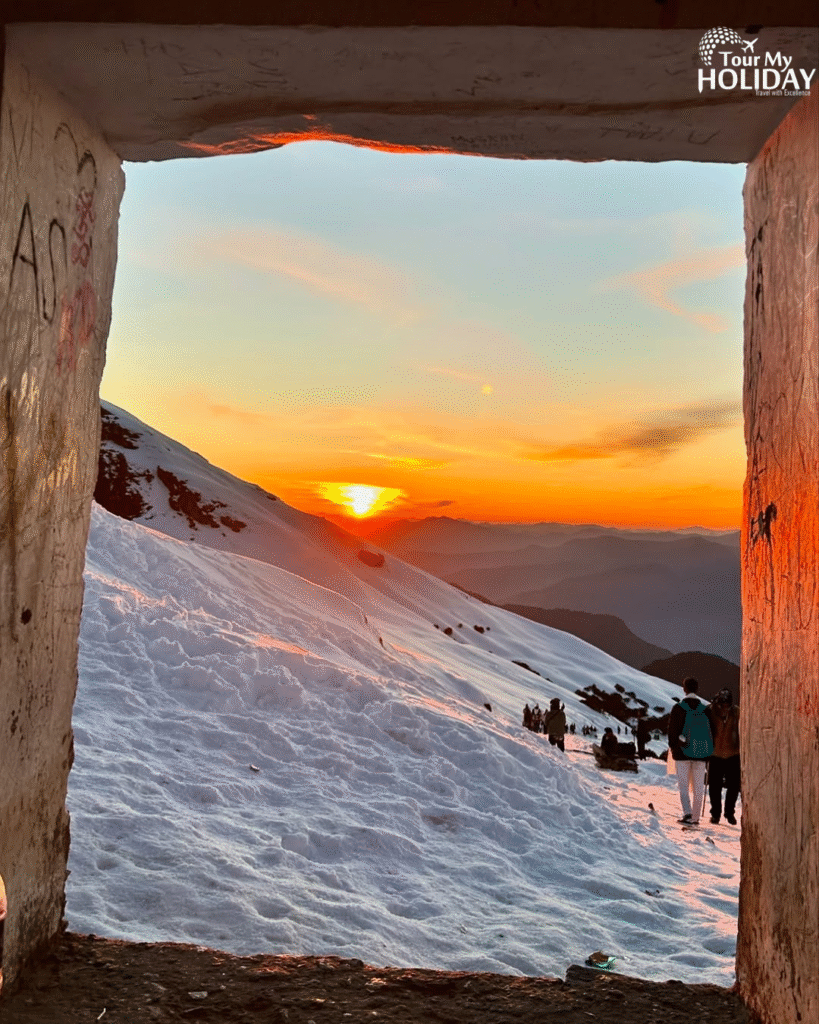
Essential Packing Guide for Chopta’s Seasons
Monsoon (July–September)
Planning a Chopta tour package during monsoon? Pack smart to embrace the rain and stay safe:
- Footwear: Waterproof trekking shoes with aggressive grip + 3 pairs of quick-dry socks (merino wool preferred)
- Rain Protection: Poncho (full-body coverage), waterproof backpack cover, and zip-lock bags for electronics
- Clothing: Quick-dry trek pants (convertible style), moisture-wicking T-shirts, and a lightweight fleece
- Must-Haves: Anti-leech socks (or regular socks + salt), microfiber towel, and waterproof phone case with lanyard
- Extras: Trekking poles (for stream crossings), antifungal powder, and spare plastic bags for wet clothes
Winter (December–February)
A winter Chopta tour package demands serious layering and cold-weather prep:
- Layering System:
- Base: Thermal innerwear (synthetic or merino)
- Mid: Fleece jacket + down vest
- Outer: Windproof hardshell jacket
- Extremities: Insulated gloves (plus spares), woolen balaclava, and ski goggles (for summit winds)
- Footwear: Waterproof snow boots (-15°C rated) + thermal socks (2 pairs/day)
- Gear: Microspikes/crampons, heated insoles, and insulated water bottle
- Emergency: Hand warmers, lip balm with SPF, and cold cream for exposed skin
Pro Tips for Both Seasons
- Monsoon: Pack clothes that dry overnight (avoid cotton)
- Winter: Use vacuum bags to compress bulky layers
- Always: Carry ORS packets and high-calorie snacks
Chopta’s Seasons: Where Mountains Wear Water and Wool
The Chopta Chandrashila trek doesn’t merely change with seasons – it rebirths itself. When monsoon arrives, the path to Tungnath Temple becomes a liquid pilgrimage. Stones that once stood firm now ripple like a mirage beneath ankle-deep streams. The forest sheds its earthly form – rhododendrons transform into emerald chandeliers, each leaf quivering with captured rain. At Deoria Tal, the lake becomes a moody artist, one moment reflecting chaos of storm clouds, the next mirroring Chaukhamba’s snowy stillness when rainbow windows briefly part the heavens.
Come winter, the same trail forgets water remembers ice. The Chandrashila summit trek becomes a silent kingdom where snow piles waist-high like frozen waves. Tungnath’s ancient steps disappear under drifts so thick, the temple seems to float above the clouds. Where monsoon played symphonies of dripping water, winter composes sonatas of crunching snow and the occasional crack of distant ice.
The Tungnath temple trek in monsoon means:
– Walking through curtains of mist that part like temple veils
– Watching priests catch raindrops in copper vessels for abhishekam
– Discovering waterfalls that bloom overnight like ephemeral flowers
The winter pilgrimage offers:
– Frozen prayer flags that chime like crystal windcatchers
– Shepherd huts where steam from snowmelt chai curls into frozen air
– Sunrise painting the summit in rose-gold alpenglow
Chopta tour packages promise adventure, but the mountains decide what form it takes. Monsoon teaches you to dance with unpredictability – to embrace soaked clothes and sudden downpours as part of the worship. Winter demands reverence – each careful footfall on icy trails a meditation, each frozen breath a whispered mantra.
The true magic? Neither season erases the other. The same bend in the trail where monsoon had you balancing on slippery rocks will have you postholing through powder snow months later. The temple courtyard where rain once pooled around your boots becomes an ice mosaic glittering under winter stars.
Chandrashila summit remembers both your faces – the monsoon version dripping with exhilaration, the winter incarnation rosy-cheeked and snow-dusted. It asks only one question: will you come back to see its other self?
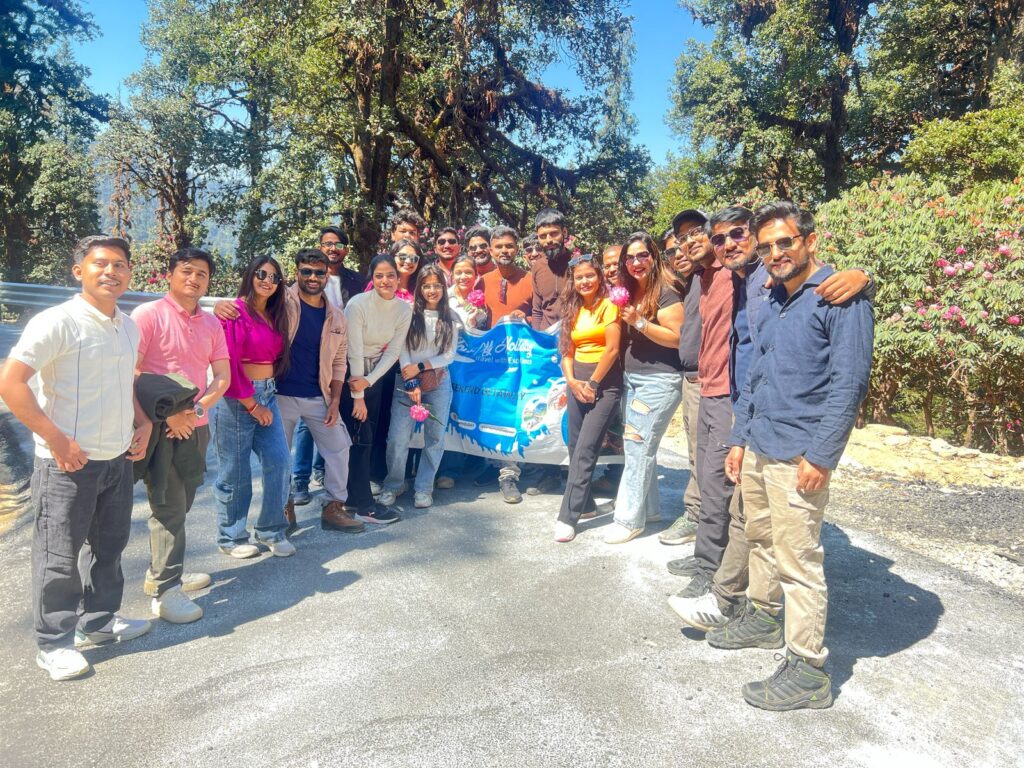
Chopta’s Seasonal Soul: Monsoon Mist vs Winter Whisper
The Chopta Chandrashila trek reveals two distinct personalities when monsoon clouds and winter winds take turns caressing its slopes. During July-September, the path to Tungnath Temple becomes a liquid meditation – mist veils 30% of the trail while newborn streams giggle across mossy stones. Come December-February, those same trails don crystalline armor, with 50% of the route glazed in black ice that sparkles like crushed diamonds under winter sun.
For photographers, the Chopta Tungnath trek from Delhi offers seasonal masterpieces. Monsoon gifts jeweled web shots at Sari Village – where dewdrops decorate spider silk like Queen’s necklace. Winter presents the “frosted mirror” of Deoria Tal – its frozen surface perfectly doubling snow-capped peaks. Both seasons share empty trails (80% fewer trekkers in monsoon, 50% less in winter), letting you capture Chandrashila’s summit without photobombers.
Temperature tells its own tale. Monsoon days (12-18°C) wrap you in cool mists as you ascend through emerald tunnels to Tungnath Temple. Winter’s bite (2-8°C daytime, plunging to -12°C at night) demands four careful layers, transforming each rest stop into a strategic gear-adjustment ritual. Your packing list morphs completely – quick-dry shirts traded for thermal armor, rain ponchos swapped for insulated gloves.
The spiritual essence of this Tungnath Chandrashila trek from Delhi also shifts with the seasons. Monsoon pilgrims receive unique blessings as rainwater mingles with temple milk offerings at Tungnath, while Dhari Devi’s raging waterfalls showcase nature’s raw power. Winter wanderers find divinity in different forms – the silent communion of snowwalk meditation, or Ukhimath’s intimate winter ceremonies when Kedarnath’s deities descend.
If your heart beats for slow travel, a Chopta tour package offers the rare luxury of stillness. Mornings in Sari Village begin with the scent of oak fires and distant temple bells, while evenings wind down beside lantern-lit trails echoing with folk tales. It’s not just about reaching a summit—it’s about savoring the journey in quiet conversation with the landscape. Whether you’re meditating beside high-altitude lakes or sharing stories over millet roti with local families, this is Himalayan travel designed for presence, not pace.
Why This Matters for Your Chopta Tour Package:
1. Monsoon rewards the agile – those who can dance with unpredictable trails
2. Winter tests the resilient – souls unafraid to earn their summit views
3. Both promise transformation – just through different elements
The Chopta Chandrashila trek doesn’t ask which season you prefer – it invites you to discover which version of yourself emerges when the mountains wear water or wool. Will you come for the monsoon’s liquid jewels or winter’s frozen poetry? The trails remember both.
Day 0: Departure from Delhi
– Pickup from Akshardham (Delhi) in the evening.
– Overnight drive to Devprayag
Himalayan Highs: 3 Days of Temples, Treks & Bonfires
Day 1: Devprayag, Sari Village & Deoria Tal
– Arrive at Devprayag, visit the sacred Alaknanda-Bhagirathi Sangam.
– Breakfast en route, then drive to Sari Village (check-in at cottages).
– Trek to Deoria Tal (short hike with stunning lake views).
– Evening: Bonfire + DJ Night with dinner at the cottages.
– Stay overnight in Sari Village.
Day 2: Tungnath & Chandrashila
– Early morning drive to Chopta (base of Tungnath trek).
– Trek to Tungnath Temple (world’s highest Shiva temple).
– Optional climb to Chandrashila Peak for panoramic Himalayan views.
– Return to Sari Village by evening.
– Dinner and rest at the cottages.
Day 3: Omkareshwar, Dhari Devi & Return
– Visit Omkareshwar Temple and Dhari Devi Temple
– Begin return journey to Delhi with lunch breaks en route.
– Drop in Delhi by late evening.
Spiritual : Devprayag Sangam, Tungnath, Omkareshwar, Dhari Devi.
Adventure : Deoria Tal trek, Chandrashila summit.
Chill : Sari Village bonfire & DJ night.
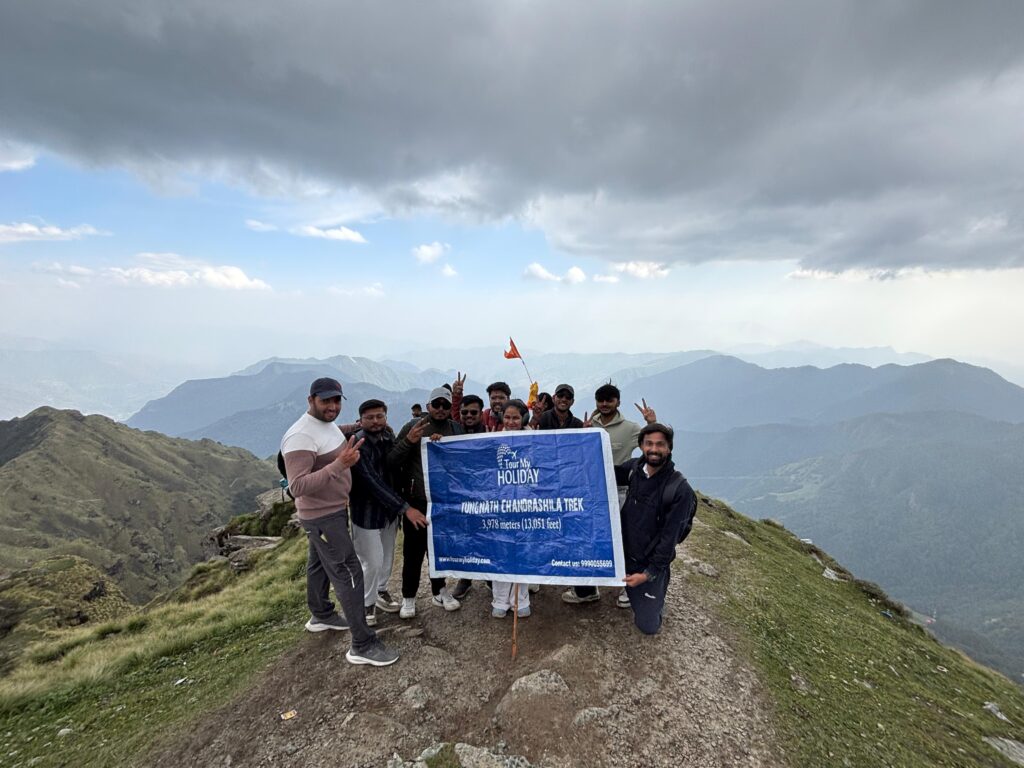
Top 5 Places to Visit Around Chopta: A Blend of Nature and Spirituality
Chopta is not just a trekker’s paradise—it’s the gateway to some of Uttarakhand’s most spiritual and scenic destinations. If you’re planning a trip, don’t miss these five spots that offer breathtaking views and divine energy.
1. Devprayag Sangam
Devprayag is the sacred meeting point of two holy rivers—Alaknanda and Bhagirathi—which merge to form the Ganga. The tranquility of this place is unmatched, making it a must-visit stop for anyone seeking peace and spiritual awakening.
👉 Learn more about Devprayag Sangam
2. Deoria Tal
Nestled in the lap of the Himalayas, Deoria Tal is a crystal-clear lake that reflects the mighty Chaukhamba peaks. The 2 km trek from Sari village is accessible and ideal for beginners, photographers, and nature lovers.
👉 Explore Deoria Tal in detail
3. Tungnath & Chandrashila Trek
Tungnath is the highest Shiva temple in the world, and the trek to Chandrashila peak offers panoramic views of the snow-clad Himalayas. It’s a moderate trek that rewards you with spiritual fulfillment and jaw-dropping scenery.
👉 Get the full guide to Tungnath & Chandrashila Trek
4. Omkareshwar Temple
Located on an island in the Narmada River, Omkareshwar Temple is shaped like the sacred ‘Om’ symbol. This Jyotirlinga shrine is revered across India and offers a unique spiritual experience amid serene surroundings.
👉 Discover Omkareshwar Temple here
5. Dhari Devi Temple
Set beside the Alaknanda River, Dhari Devi Temple is dedicated to Uttarakhand’s protective goddess. Locals believe the deity’s form changes with time of day, adding a mystical charm to this holy place.
👉 If you’d like to know more about Dhari Devi just click here
What Makes This Chopta Trek Experience Exceptional
The magic of experiencing the Chandrashila trek in both seasons lies in the carefully crafted expertise behind the journey. Unlike standard itineraries, a thoughtfully designed Chopta tour package adapts intelligently to nature’s moods—monsoon treks reroute gracefully around newborn streams, while winter ascents begin at dawn to outsmart mountain winds.
Local wisdom transforms the experience. Guides who’ve walked these trails 100+ times reveal hidden wonders—secret sunrise viewpoints near Tungnath Temple, or the best shepherd huts for winter chai breaks. Their connections with Sari Village families unlock authentic Himalayan hospitality you won’t find on commercial routes.
Safety shines through thoughtful details. Monsoon hikers find emergency ponchos magically appearing when clouds burst, while winter trekkers appreciate oxygen reserves at basecamp—crucial for those battling altitude in freezing temperatures. Every backpack includes seasonal survival kits: from anti-leech salt packets to hand warmers.
The commitment to ethical travel runs deep. Refill stations eliminate plastic bottles along the Chopta Tungnath trek route, and a portion of fees funds village schools. You’ll taste this philosophy in home-cooked meals using local ingredients, served on reusable steel plates rather than disposable ware.
For photographers, guides know exactly where monsoon’s rainbow windows appear at Deoria Tal, or how to capture winter’s diamond dust sunrise at Chandrashila summit. Their timing instincts ensure you’re positioned perfectly when nature’s lightshow begins.
What truly sets this experience apart is the seamless harmony of adventure and responsibility—where thrilling summit pushes coexist with quiet respect for mountain ecosystems. Whether you come for monsoon’s liquid emerald trails or winter’s frozen wonderland, every detail reflects decades of Himalayan reverence.
For the Spirit Seekers: Monsoon’s Embrace
The Tungnath temple trek during the rainy season (July–September) offers a baptism by mountain mist unlike any other. There’s something profoundly spiritual about watching raindrops mingle with milk offerings at Tungnath Temple, as if the heavens themselves are participating in the puja. The trails become liquid meditation paths—your boots splashing through sacred streams that appear overnight. At Deoria Tal, when those rare cloud partings reveal the reflection of Chaukhamba’s peaks in the rain-kissed waters, you’ll understand why monsoon pilgrims speak of these moments with reverence—and why this season adds a mystical layer to your Chopta tour package experience.
For the Adventure Purists: Winter’s Challenge
December-February transforms the Tungnath temple trek into a crystalline odyssey. That heart-pounding moment when your crampons first bite into the ice-glazed trail to Chandrashila summit becomes a rite of passage. Winter rewards the bold with sights like Tungnath’s stone arches draped in icicles that chime like temple bells in the wind. The physical challenge—battling temperatures that plunge to -12°C—makes each sip of snowmelt chai at shepherd huts taste like victory nectar.
The Deeper Truth Behind Your Chopta Tour Package
Having experienced both through TourMyHoliday Chopta tour packages, I’ve learned these seasons aren’t competitors but complementary verses in the mountain’s eternal poem. Monsoon teaches surrender—to dance with unpredictability and find joy in soaked clothes. Winter demands resilience—to march through breath-stealing cold toward sunrise panoramas that redefine beauty.
Your Perfect Choice
-Monsoon calls if you seek
Spiritual connection through nature’s drama
Emerald landscapes untouched by crowds
The thrill of chasing fleeting cloud-break views
– Winter sings if you crave:
Physical accomplishment in pristine snowscapes
Crystal-clear Himalayan vistas
The profound silence of snow-muffled trails
In the end, the Chandrashila trek doesn’t ask you to choose—it invites you to return. My monsoon-worn boots and winter-tested gloves both sit on my shelf as equal treasures, each whispering different mountain secrets. Perhaps the real verdict is this: one season introduces you to the Himalayas, but it takes both to know them.
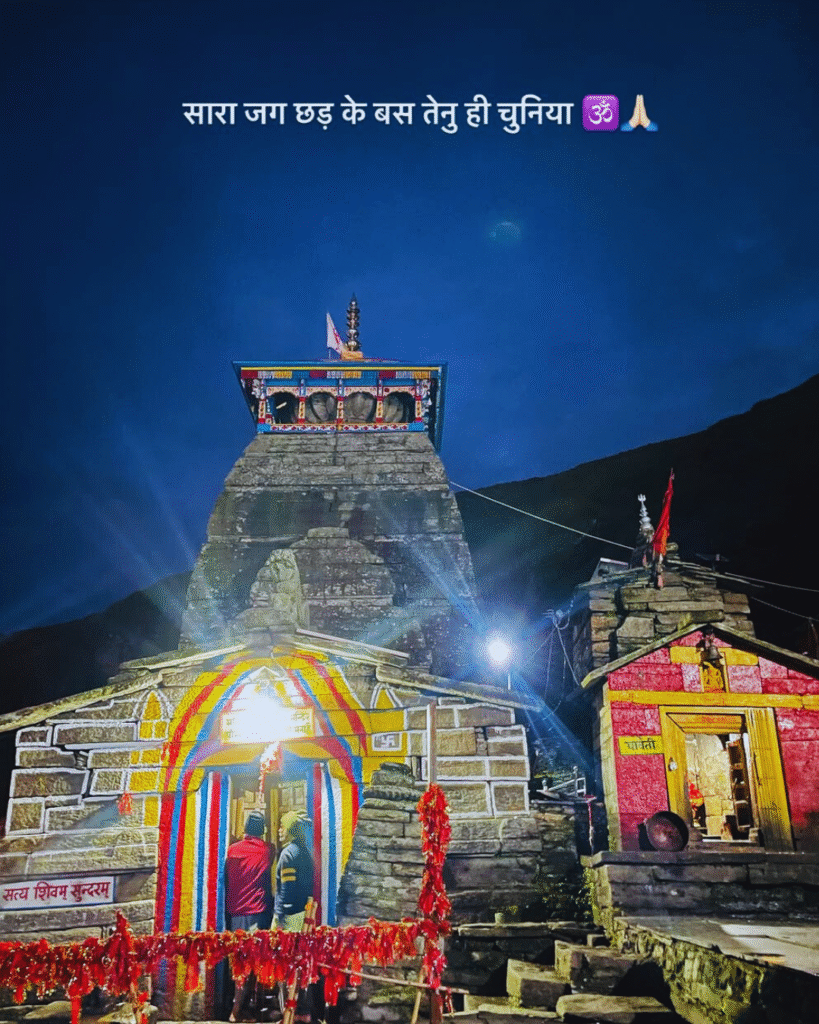
Frquently Asked Questions
- What’s the ideal time to explore Chopta and its surrounding treks?
Spring (April–June) offers lush greenery, while winter (December–February) transforms the landscape into a snowy wonderland—each season providing a distinct experience for trekkers. - Is the Chopta tour package suitable for beginners?
Yes, many Chopta tour packages are beginner-friendly, with manageable gradients and expert local guides who assist every step of the way. - What’s included in a standard Chopta tour package?
Most packages include stay, meals, local transport, trekking guides, and sometimes entry permits for places like Tungnath and Chandrashila. - How difficult is the Chopta Tungnath trek?
It’s considered moderate. The trail to Tungnath Temple is well-defined, and a gradual climb makes it doable even for first-timers. - What’s unique about the Chandrashila summit trek?
At 4,000 meters, it offers 360° views of peaks like Nanda Devi, Trishul, and Chaukhamba—one of the most rewarding short treks in Uttarakhand. - Do I need a guide for the Chopta Chandrashila trek?
While it’s possible to go solo, hiring a guide enhances safety and lets you discover hidden viewpoints that most tourists miss. - Are there Chopta tour packages available from Delhi?
Absolutely! Several operators offer direct itineraries, making the Chopta Chandrashila trek from Delhi a popular weekend escape. - What kind of accommodation is available in Chopta?
Options range from budget tents to cozy eco-lodges and warm wooden cottages—often included in your Chopta tour package. - Can I do birdwatching or photography during the trek?
Yes! Chopta is a paradise for bird lovers and photographers. Guides in premium Chopta tour packages know the best spots and timing for that perfect shot. - Is camping allowed in Chopta?
Yes, camping is permitted in designated zones. Many Chopta Tungnath trek packages offer overnight stays under starlit skies. - What kind of food is served during these treks?
Mostly vegetarian meals with a local Garhwali touch—think hot phulkas, dal, seasonal veggies, and masala chai served around the campfire. - Is the trail safe during monsoon?
It can get slippery. However, monsoon-focused Chopta tour packages offer rain gear, emergency supplies, and adjusted timings for safer hikes. - How cold does it get in winter treks?
Temperatures can drop below -10°C near Chandrashila summit, so packages come prepared with gear like crampons, heated bottles, and layered clothing tips. - How long is the Tungnath Temple trek?
The trek is around 3.5 km one way from Chopta—steep but manageable, and it takes about 2 hours depending on your pace. - Why choose a curated tour package instead of a DIY trek?
Local expertise, safer routes, sustainable travel practices, and built-in comforts make a curated Chopta tour package a richer and hassle-free experience.

